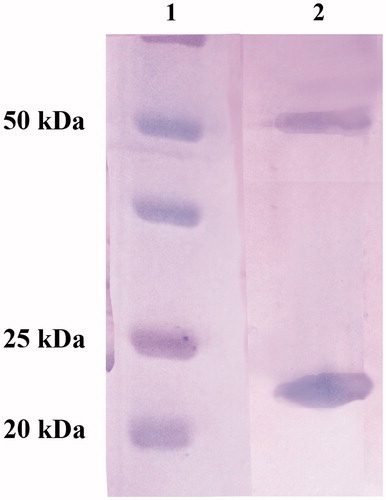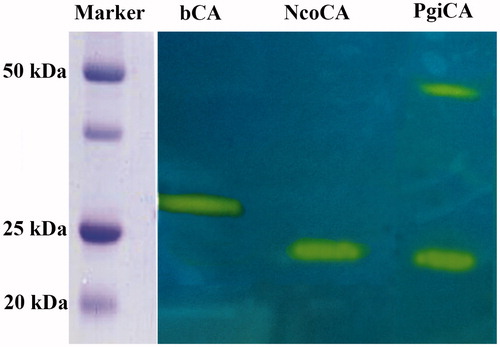Figures & data
Figure 1. Amino acid sequence alignment of NcoCA and PgiCA (γ-CA). The metal ion ligands (His81, Hist117 and His122) are indicated in bold. The multialignment was performed with the program Muscle. Numbering system of the most known γ-CA, named CAM, was used Citation99,Citation100. The asterisk (*) indicates identity at all aligned positions; the symbol (:) relates to conserved substitutions, while (.) means that semi-conserved substitutions are observed.

Figure 2. SDS-PAGE of the recombinant NcoCA purified from E. coli cells. Legend: Lane 1, molecular markers; Lane 2, purified NcoCA from His-tag affinity column. NcoCA showed two bands: one corresponding to a monomer with an apparent molecular weight of 22 kDa; the second band showed an apparent molecular weight of 55 kDa.

Figure 3. Protonogram obtained using bCA (α-CA) and two γ-CAs: the Antarctic NcoCA and mesophilic PgiCA. The yellow bands correspond to the CA position on the gel responsible for the drop of pH from 8.2 to the transition point of the dye in the control buffer. Incubation time was of 20 s. NcoCA showed only one band (22 kDa), while PgiCA was present in two oligomeric states, the monomeric (22 kDa) and the trimeric (55 kDa) forms (see text for details).

Table 1. Kinetic parameters for the CO2 hydration reaction catalyzed by the α-, β- and γ-CAs at 20 °C and pH 7.5 in 10 mM HEPES buffer and 20 mM Na2SO4, measured at 20 °C, pH 8.3 in 20 mM TRIS buffer and 20 mM NaClO4Citation77.
Figure 4. Thermostability of NcoCA and PgiCA. The enzymes were incubated for 10 (A), 20 (B) and 60 (C) min at the temperatures of 4, 10, 30, 40, 50, and 60 °C. Enzyme activity were assayed using CO2 as substrate.

